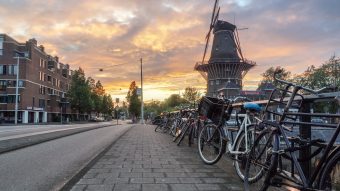
Cycling is a big part of Amsterdam’s clean transport story. The city has more bikes than people and is increasing the number of green bikeways, separated from roads.
“More and more, we’re biking,” said Peter Paul Ekker, spokesman for Amsterdam Alderman Abdeluheb Choho, vice mayor for sustainability. As described in an earlier article in this series, “Strong Support in Amsterdam for City’s Climate and Sustainability Efforts,” the city intends public transport to be totally electric by 2025, at which point all taxis also will need to be electric.
It also plans to completely bar older, dirtier fossil-fueled vehicles from entering the city. Some restrictions on conventional commercial vehicles are already in place.
A Clean and Circular Economy
Once Amsterdam officials realized that the city could replace a third of the building materials it uses annually by recovering and reusing them, the city became a strong proponent of the “circular economy.”
“You need to build smart,” Ekker said, constructing buildings so raw materials can be more easily recovered once the building has reached the end of its useful lifespan.
All concrete that the city uses in the future will be recycled—“a huge CO2 reduction,” according to Ekker. In contracting with developers for buildings in Amsterdam, 30 percent of a prospective project’s rating is based on its sustainability score.
Amsterdam is not just focusing on its “tear downs.” The city is keen on retrofitting buildings to make them more energy efficient. Nowhere is this concern more evident than when it comes to school buildings.
Green Schools, Clean Energy
Amsterdammers are solicitous of their next generation.
“All schools will have green roofs, solar panels, good insulation,” Ekker said. Green roofs insulate the building, reducing the need for heating and cooling. They thereby improve air quality along with occupants’ comfort. “It’s a win-win situation,” he noted.
The city plans to increase the number of households with rooftop solar generators from 5,000 to 80,000 by 2020 while it expands the city’s wind power generating capacity from 67 MW to 85 MW. But whereas many residents are interested in solar, relatively few have suitable roofs.
To meet this challenge, the city has been working with owners of large factory and commercial roofs since 2015 to arrange for them to lease their roofs to residents for solar generation.
Waste-to-Energy
In adhering to its ideals of a circular economy, Amsterdam is reusing municipal waste to co-generate heat and power for residents in northern and western Amsterdam. The waste is collected and delivered to a central incinerator with advanced pollution controls. Heat generated by the plant is distributed to households in large insulated pipes, replacing individual gas furnaces.
In addition, excess heat from a gas-fired power plant on the east side of Amsterdam in Diemen currently serves residents in the city’s southern and eastern quadrants, and the city is planning to create a region-wide heat network.
All told, Amsterdam plans to have 102,000 homes on district heating by 2020 and 240,000 by 2040. Geothermal heat sources and surplus heat from urban greenhouses, where flowers and vegetables are grown, will provide heat to the regional heat-network.
Amsterdam’s leaders understand that clean air and clean water are essential if the city is to be habitable, sustainable, and attractive to residents and businesses in the future. They know that a clean environment is intrinsically more attractive than a polluted one and that it is not only compatible with economic prosperity, but conducive to it.
By emphasizing the health and economic benefits of their climate and energy programs, they’ve built a strong public consensus in its favor.
Source: renewableenergyworld.com



